How To Calculate 5 Of A Number
News Co
Apr 27, 2025 · 4 min read

Table of Contents
How to Calculate 5% of a Number: A Comprehensive Guide
Calculating percentages is a fundamental skill with widespread applications in various fields, from finance and budgeting to sales and statistics. Understanding how to calculate 5% of a number is particularly useful because it frequently arises in everyday situations, such as calculating sales tax, discounts, tips, or interest rates. This comprehensive guide will walk you through multiple methods for calculating 5%, ensuring you master this essential skill regardless of your mathematical background.
Understanding Percentages
Before diving into the calculations, let's solidify our understanding of percentages. A percentage is a fraction or ratio expressed as a part of 100. The symbol "%" represents "per hundred." Therefore, 5% means 5 out of 100, or 5/100, which simplifies to 1/20. This fraction representation is key to understanding several calculation methods.
Method 1: Using the Decimal Equivalent
This is arguably the most straightforward method. Since 5% is equivalent to 5/100, we can express it as a decimal by dividing 5 by 100:
5 ÷ 100 = 0.05
To calculate 5% of any number, simply multiply the number by 0.05.
Example: Let's find 5% of 200.
200 x 0.05 = 10
Therefore, 5% of 200 is 10.
Advantages: This method is quick, efficient, and easily adaptable for calculating other percentages by simply changing the decimal equivalent.
Disadvantages: Some individuals may find converting percentages to decimals slightly less intuitive than other methods.
Method 2: Using the Fraction Equivalent
As mentioned earlier, 5% is equivalent to the fraction 1/20. This means calculating 5% of a number is the same as finding one-twentieth of that number.
Example: Let's again find 5% of 200.
200 x (1/20) = 200 ÷ 20 = 10
Therefore, 5% of 200 is 10.
Advantages: This method is particularly useful when the number is easily divisible by 20. It offers a clear visual representation of the percentage as a part of the whole.
Disadvantages: It might be less efficient if the number isn't easily divisible by 20, potentially requiring more complex division.
Method 3: Using Proportions
This method relies on setting up a proportion to solve for the unknown value (5% of the number). We can express the problem as a ratio:
5/100 = x/Total Number
Where 'x' represents 5% of the total number.
Example: Find 5% of 350.
5/100 = x/350
To solve for 'x', cross-multiply:
100x = 5 * 350 100x = 1750 x = 1750 ÷ 100 x = 17.5
Therefore, 5% of 350 is 17.5
Advantages: This method provides a structured approach, particularly helpful in understanding the underlying relationship between percentages and proportions. It's also adaptable to calculating other percentages.
Disadvantages: It can be more time-consuming than the decimal or fraction methods, especially for those unfamiliar with solving proportions.
Method 4: Using a Calculator
Calculators provide the simplest and most efficient way to calculate percentages, especially for complex numbers or when speed is crucial. Most calculators have a percentage button ("%"). The process typically involves entering the number, multiplying it by 5, and then pressing the "%" button. Some calculators might require a slightly different sequence of operations. Refer to your calculator's manual for specific instructions.
Example: To find 5% of 1250 using a calculator, you would typically enter: 1250 x 5 % = The result would be 62.5.
Advantages: Speed, accuracy, and ease of use, particularly beneficial for large or complex calculations.
Disadvantages: Over-reliance on calculators can hinder the development of mental math skills.
Practical Applications of Calculating 5%
The ability to quickly calculate 5% is incredibly useful in many real-world situations:
-
Sales Tax: Many regions have a sales tax rate close to 5%. Knowing how to calculate 5% quickly allows for an immediate estimate of the total cost.
-
Discounts: Sales and promotions often offer 5% discounts. Quickly determining the discount amount helps in making informed purchasing decisions.
-
Tips: Calculating a 5% tip in a restaurant or for a service provider is straightforward using the methods discussed above.
-
Interest Rates: Understanding 5% interest calculations helps in managing personal finances and loans.
-
Statistical Analysis: Percentages are fundamental in various statistical analyses, and calculating 5% is often a necessary step.
Mastering Percentage Calculations: Tips and Tricks
Beyond the methods outlined, mastering percentage calculations involves developing some crucial skills:
-
Mental Math: Practice calculating percentages mentally. Start with simple numbers and gradually increase the complexity. This enhances your speed and reduces reliance on calculators.
-
Understanding the Relationship between Percentages and Fractions: Familiarity with common fraction equivalents of percentages (e.g., 5% = 1/20, 10% = 1/10, 25% = 1/4) significantly speeds up calculations.
-
Estimation: Learn to estimate percentages. This helps in quickly checking the reasonableness of your answers and identifying potential calculation errors.
-
Practice Regularly: The key to mastering any skill is consistent practice. Use everyday situations to practice calculating percentages.
Conclusion
Calculating 5% of a number is a crucial skill with numerous practical applications. This guide has presented four distinct methods – using decimal equivalents, fraction equivalents, proportions, and calculators – allowing you to choose the approach that best suits your mathematical proficiency and the specific context of the calculation. By mastering these methods and integrating them into your daily practice, you’ll enhance your numeracy skills and confidently tackle percentage calculations in various real-world scenarios. Remember that consistent practice and understanding the underlying principles are key to achieving mastery in percentage calculations.
Latest Posts
Related Post
Thank you for visiting our website which covers about How To Calculate 5 Of A Number . We hope the information provided has been useful to you. Feel free to contact us if you have any questions or need further assistance. See you next time and don't miss to bookmark.